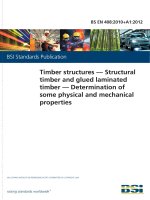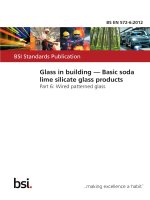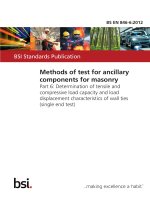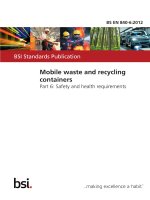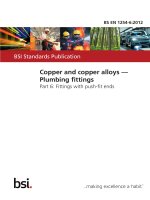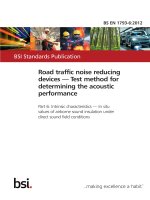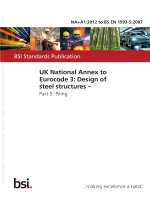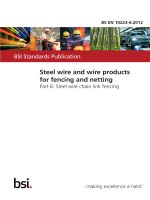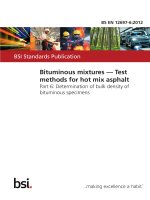Bsi bs en 61158 6 15 2012
Bạn đang xem bản rút gọn của tài liệu. Xem và tải ngay bản đầy đủ của tài liệu tại đây (1.5 MB, 110 trang )
BS EN 61158-6-15:2012
BSI Standards Publication
Industrial communication
networks — Fieldbus
specifications
Part 6-15: Application layer protocol
specification — Type 15 elements
BS EN 61158-6-15:2012 BRITISH STANDARD
National foreword
This British Standard is the UK implementation of EN 61158-6-15:2012. It is
identical to IEC 61158-6-15:2010. It supersedes BS EN 61158-6-15:2008
which is withdrawn.
The UK participation in its preparation was entrusted to Technical Committee
AMT/7, Industrial communications: process measurement and control,
including fieldbus.
A list of organizations represented on this committee can be obtained on
request to its secretary.
This publication does not purport to include all the necessary provisions of a
contract. Users are responsible for its correct application.
© The British Standards Institution 2012
Published by BSI Standards Limited 2012
ISBN 978 0 580 71568 6
ICS 25.04.40; 35.100.70; 35.110
Compliance with a British Standard cannot confer immunity from
legal obligations.
This British Standard was published under the authority of the Standards
Policy and Strategy Committee on 31 July 2012.
Amendments issued since publication
Amd. No. Date Text affected
EUROPEAN STANDARD BS EN 61158-6-15:2012
NORME EUROPÉENNE
EUROPÄISCHE NORM EN 61158-6-15
ICS 25.040.40; 35.100.70; 35.110 June 2012 Supersedes EN 61158-6-15:2008
English version
Industrial communication networks -
Fieldbus specifications -
Part 6-15: Application layer protocol specification -
Type 15 elements
(IEC 61158-6-15:2010)
Réseaux de communication industriels - Industrielle Kommunikationsnetze -
Spécifications des bus de terrain - Feldbusse -
Partie 6-15: Spécification des protocoles Teil 6-15: Protokollspezifikation des
des couches d'application - Application Layer (Anwendungsschicht) -
Eléments de type 15 Typ 15-Elemente
(CEI 61158-6-15:2010) (IEC 61158-6-15:2010)
This European Standard was approved by CENELEC on 2012-03-28. CENELEC members are bound to comply
with the CEN/CENELEC Internal Regulations which stipulate the conditions for giving this European Standard
the status of a national standard without any alteration.
Up-to-date lists and bibliographical references concerning such national standards may be obtained on
application to the CEN-CENELEC Management Centre or to any CENELEC member.
This European Standard exists in three official versions (English, French, German). A version in any other
language made by translation under the responsibility of a CENELEC member into its own language and notified
to the CEN-CENELEC Management Centre has the same status as the official versions.
CENELEC members are the national electrotechnical committees of Austria, Belgium, Bulgaria, Croatia, Cyprus,
the Czech Republic, Denmark, Estonia, Finland, France, Germany, Greece, Hungary, Iceland, Ireland, Italy,
Latvia, Lithuania, Luxembourg, Malta, the Netherlands, Norway, Poland, Portugal, Romania, Slovakia, Slovenia,
Spain, Sweden, Switzerland, Turkey and the United Kingdom.
CENELEC
European Committee for Electrotechnical Standardization
Comité Européen de Normalisation Electrotechnique
Europäisches Komitee für Elektrotechnische Normung
Management Centre: Avenue Marnix 17, B - 1000 Brussels
© 2012 CENELEC - All rights of exploitation in any form and by any means reserved worldwide for CENELEC members.
Ref. No. EN 61158-6-15:2012 E
BS EN 61158-6-15:2012
EN 61158-6-15:2012 - 2 -
Foreword
The text of document 65C/607/FDIS, future edition 2 of IEC 61158-6-15, prepared by SC 65C, "Industrial
networks", of IEC/TC 65, "Industrial-process measurement, control and automation" was submitted to the
IEC-CENELEC parallel vote and approved by CENELEC as EN 61158-6-15:2012.
The following dates are fixed: (dop) 2012-12-28
(dow) 2015-03-28
• latest date by which the document has
to be implemented at national level by
publication of an identical national
standard or by endorsement
• latest date by which the national
standards conflicting with the
document have to be withdrawn
This document supersedes EN 61158-6-15:2008.
EN 61158-6-15:2012 includes the following significant technical changes with respect to EN 61158-6-
15:2008:
– editorial corrections.
Attention is drawn to the possibility that some of the elements of this document may be the subject of
patent rights. CENELEC [and/or CEN] shall not be held responsible for identifying any or all such patent
rights.
Endorsement notice
The text of the International Standard IEC 61158-6-15:2010 was approved by CENELEC as a European
Standard without any modification.
In the official version, for Bibliography, the following note has to be added for the standard indicated:
IEC/TR 61158-1:2010 NOTE Harmonized as CLC/TR 61158-1:2010 (not modified).
BS EN 61158-6-15:2012
- 3 - EN 61158-6-15:2012
Annex ZA
(normative)
Normative references to international publications
with their corresponding European publications
The following documents, in whole or in part, are normatively referenced in this document and are
indispensable for its application. For dated references, only the edition cited applies. For undated
references, the latest edition of the referenced document (including any amendments) applies.
NOTE When an international publication has been modified by common modifications, indicated by (mod), the relevant EN/HD
applies.
Publication Year Title EN/HD Year
IEC 61158-5-15 2010 2012
Industrial communication networks - Fieldbus EN 61158-5-15
ISO/IEC 7498-1 - specifications - -
ISO/IEC 8822 - Part 5-15: Application layer service definition - -
ISO/IEC 8824-1 - Type 15 elements -
ISO/IEC 9545 - -
Information technology - Open Systems -
Interconnection - Basic Reference Model:
The Basic Model
Information technology - Open Systems -
Interconnection - Presentation service
definition
Information technology - Abstract Syntax -
Notation One (ASN.1): Specification of basic
notation
Information technology - Open Systems -
Interconnection - Application Layer structure
– 2 – BS EN 61158-6-15:2012
61158-6-15 © IEC:2010(E)
CONTENTS
INT RODUCT IO N ..................................................................................................................... 81H
1 Scope ...............................................................................................................................92H
1.1 General ...................................................................................................................93H
1.2 Specifications ..........................................................................................................94H
1.3 Conformance......................................................................................................... 15H 0
2 Normative references ..................................................................................................... 16H 0
3 Terms and definitions, abbreviations, symbols and conventions ..................................... 17H 0
3.1 Terms and definitions ............................................................................................ 18H 0
3.2 Abbreviations and symbols .................................................................................... 19H 7
3.3 Conventions .......................................................................................................... 110H 9
3.4 Conventions used in state machines ..................................................................... 21H 1
4 Abstract syntax for client/server ..................................................................................... 212H 2
5 Transfer syntax for client/server ..................................................................................... 213H 2
5.1 General ................................................................................................................. 214H 2
5.2 Common APDU structure ...................................................................................... 215H 2
5.3 Service-specific APDU structures .......................................................................... 216H 6
5.4 Data representation ‘on the wire’ ........................................................................... 517H 1
6 Abstract syntax for publish/subscribe ............................................................................. 518H 1
7 Transfer syntax for publish/subscribe ............................................................................. 519H 2
7.1 General ................................................................................................................. 520H 2
7.2 APDU structure ..................................................................................................... 521H 2
7.3 Sub-message structure ......................................................................................... 52H 3
7.4 APDU interpretation .............................................................................................. 523H 5
7.5 Service specific APDU structures .......................................................................... 524H 7
7.6 Common data representation for publish/subscribe ............................................... 725H 9
8 Structure of FAL protocol state machines ....................................................................... 826H 3
9 AP-context state machines for client/server .................................................................... 827H 5
10 FAL service protocol machine (FSPM) for client/server ................................................... 828H 5
10.1 General ................................................................................................................. 829H 5
10.2 FSPM state tables ................................................................................................. 830H 5
10.3 Functions used by FSPM ....................................................................................... 931H 2
10.4 Parameters of FSPM/ARPM primitives .................................................................. 932H 2
10.5 Client/server server transactions ........................................................................... 93H 2
11 Application relationship protocol machines (ARPMs) for client/server ............................. 934H 4
11.1 Application relationship protocol machines (ARPMs) ............................................. 935H 4
11.2 AREP state machine primitive definitions .............................................................. 936H 5
11.3 AREP state machine functions .............................................................................. 937H 6
12 DLL mapping protocol machine (DMPM) for client/server ................................................ 938H 6
12.1 AREP mapping to data link layer ........................................................................... 939H 6
12.2 DMPM states ......................................................................................................... 940H 7
12.3 DMPM state machine ............................................................................................ 941H 7
12.4 Primitives exchanged between data link layer and DMPM ..................................... 942H 8
12.5 Client/server on TCP/IP ......................................................................................... 943H 8
13 AP-Context state machines for publish/subscribe ......................................................... 14H 02
BS EN 61158-6-15:2012 – 3 –
61158-6-15 © IEC:2010(E)
14 Protocol machines for publish/subscribe ....................................................................... 145H 02
14.1 General ............................................................................................................... 146H 02
14.2 Publish/subscribe on UDP ................................................................................... 147H 04
Bibliography........................................................................................................................ 148H 05
Figure 1 – APDU Format ....................................................................................................... 249H 2
Figure 2 – Client to server confirmed service request............................................................ 250H 4
Figure 3 – Normal response from server to client .................................................................. 251H 4
Figure 4 – Exception response from server to client .............................................................. 252H 4
Figure 5 – Client to server unconfirmed service request........................................................ 253H 5
Figure 6 – Publish/subscribe APDU ...................................................................................... 554H 2
Figure 7 – Flags of issue request .......................................................................................... 55H 8
Figure 8 – Flags of heartbeat request ................................................................................... 656H 0
Figure 9 – Flags of VAR request ........................................................................................... 657H 4
Figure 10 – Flags of GAP request ......................................................................................... 658H 6
Figure 11 – Flags of ACK request ......................................................................................... 659H 8
Figure 12 – Flags of INFO_DST request ............................................................................... 760H 2
Figure 13 – Flags of INFO_REPLY request ........................................................................... 761H 3
Figure 14 – Flags of INFO_SRC request ............................................................................... 762H 5
Figure 15 – Flags of INFO_TS request.................................................................................. 763H 7
Figure 16 – Flags of PAD request ......................................................................................... 764H 8
Figure 17 – Encoding of octet ............................................................................................... 865H 0
Figure 18 – Encoding of boolean .......................................................................................... 86H 0
Figure 19 – Encoding of unsigned short ................................................................................ 867H 0
Figure 20 – Encoding of unsigned long ................................................................................. 868H 0
Figure 21 – Encoding of unsigned long long.......................................................................... 869H 1
Figure 22 – Encoding of float ................................................................................................ 870H 1
Figure 23 – Encoding of double ............................................................................................ 871H 1
Figure 24 – Relationships among protocol machines and adjacent layers ............................. 872H 4
Figure 25 – State transition diagram of FSPM ....................................................................... 873H 5
Figure 26 – Transaction state machine, per connection ........................................................ 874H 6
Figure 27 – Client/server server transactions ........................................................................ 975H 3
Figure 28 – State transition diagram of the Client ARPM....................................................... 976H 4
Figure 29 – State transition diagram of the server ARPM ...................................................... 97H 5
Figure 30 – State transition diagram of DMPM ...................................................................... 978H 7
Figure 31 – APDU Format ..................................................................................................... 979H 8
Figure 32 – TCP/IP PDU Format ........................................................................................... 980H 9
Figure 33 – Publish/subscribe receiver ............................................................................... 181H 03
Table 1 – Conventions used for state machines .................................................................... 282H 1
Table 2 – Exception code...................................................................................................... 283H 5
Table 3 – Read discretes request ......................................................................................... 284H 6
Table 4 – Read discretes response ....................................................................................... 285H 6
– 4 – BS EN 61158-6-15:2012
61158-6-15 © IEC:2010(E)
Table 5 – Read coils request ................................................................................................ 286H 7
Table 6 – Read coils response .............................................................................................. 287H 7
Table 7 – Write single coil request ........................................................................................ 28H 8
Table 8 – Write single coil response ..................................................................................... 289H 8
Table 9 – Write multiple coils request ................................................................................... 290H 9
Table 10 – Write multiple coils response ............................................................................... 291H 9
Table 11 – Broadcast write single coil request ...................................................................... 392H 0
Table 12 – Broadcast write multiple coils request.................................................................. 393H 1
Table 13 – Read input registers request ............................................................................... 394H 1
Table 14 – Read input registers response ............................................................................. 395H 2
Table 15 – Read holding registers request ............................................................................ 396H 2
Table 16 – Read holding registers response ......................................................................... 397H 3
Table 17 – Write single holding register request ................................................................... 398H 3
Table 18 – Write single holding register response ................................................................. 39H 4
Table 19 – Write multiple holding registers request ............................................................... 310H 4
Table 20 – Write multiple holding registers response ............................................................ 310H 5
Table 21 – Mask write holding register request ..................................................................... 3102H 6
Table 22 – Mask write holding register request ..................................................................... 3103H 6
Table 23 – Read/Write multiple holding registers request...................................................... 3104H 7
Table 24 – Read/Write multiple holding registers response ................................................... 3105H 8
Table 25 – Read FIFO request .............................................................................................. 3106H 8
Table 26 – Read FIFO response ........................................................................................... 3107H 9
Table 27 – Broadcast write single holding register request.................................................... 4108H 0
Table 28 – Broadcast write multiple holding registers request ............................................... 4109H 1
Table 29 – Read file record request ...................................................................................... 410H 2
Table 30 – Read file record response ................................................................................... 41H 3
Table 31 – Write file record request ...................................................................................... 412H 4
Table 32 – Write file record response ................................................................................... 413H 6
Table 33 – Read device identification request ....................................................................... 414H 7
Table 34 – Device identification categories ........................................................................... 415H 8
Table 35 – Read device ID code ........................................................................................... 416H 8
Table 36 – Read device identification response .................................................................... 417H 9
Table 37 – Conformity level .................................................................................................. 518H 0
Table 38 – Requested vs. returned known objects ................................................................ 519H 1
Table 39 – APDU structure ................................................................................................... 5120H 3
Table 40 – Sub-message structure ....................................................................................... 512H 4
Table 41 – Publish/subscribe service identifier encoding ...................................................... 512H 4
Table 42 – Attributes changed modally and affecting APDUs interpretations ......................... 5123H 6
Table 43 – Issue request ...................................................................................................... 5124H 7
Table 44 – Meaning of issue request flags ............................................................................ 5125H 8
Table 45 – Interpretation of issue.......................................................................................... 5126H 9
Table 46 – Heartbeat request ............................................................................................... 6127H 0
Table 47 – Meaning of heartbeat request flags ..................................................................... 6128H 1
BS EN 61158-6-15:2012 – 5 –
61158-6-15 © IEC:2010(E)
Table 48 – Interpretation of heartbeat ................................................................................... 6129H 2
Table 49 – VAR request ........................................................................................................ 6130H 3
Table 50 – Meaning of VAR request flags ............................................................................. 613H 4
Table 51 – Interpretation of VAR ........................................................................................... 6132H 5
Table 52 – GAP request........................................................................................................ 613H 6
Table 53 – Meaning of GAP request flags ............................................................................. 6134H 7
Table 54 – Interpretation of GAP........................................................................................... 6135H 7
Table 55 – ACK request ........................................................................................................ 6136H 8
Table 56 – Meaning of ACK request flags ............................................................................. 6137H 9
Table 57 – Interpretation of ACK ........................................................................................... 6138H 9
Table 58 – Header request ................................................................................................... 7139H 0
Table 59 – Change in state of the receiver ............................................................................ 7140H 1
Table 60 – INFO_DST request .............................................................................................. 714H 1
Table 61 – Meaning of INFO_DST request flags ................................................................... 7142H 2
Table 62 – INFO_REPLY request ......................................................................................... 7143H 3
Table 63 – Meaning of INFO_REPLY request flags ............................................................... 714H 4
Table 64 – INFO_SRC request ............................................................................................. 7145H 5
Table 65 – Meaning of INFO_SRC request flags ................................................................... 7146H 5
Table 66 – INFO_TS request ................................................................................................ 7147H 6
Table 67 – Meaning of INFO_TS request flags ...................................................................... 7148H 7
Table 68 – PAD request ........................................................................................................ 7149H 8
Table 69 – Meaning of PAD request flags ............................................................................. 7150H 8
Table 70 – Semantics ........................................................................................................... 715H 9
Table 71 – FSPM state table – client transactions ................................................................. 8152H 7
Table 72 – FSPM state table – server transactions ............................................................... 9153H 2
Table 73 – Function MatchInvokeID().................................................................................... 9154H 2
Table 74 – Function HighBit() ............................................................................................... 915H 2
Table 75 – Parameters used with primitives exchanged between FSPM and ARPM .............. 9156H 2
Table 76 – Client ARPM states ............................................................................................. 9157H 4
Table 77 – Client ARPM state table ...................................................................................... 9158H 4
Table 78 – Server ARPM states ............................................................................................ 9159H 4
Table 79 – Server ARPM state table ..................................................................................... 9160H 5
Table 80 – Primitives issued from ARPM to DMPM ............................................................... 916H 5
Table 81 – Primitives issued by DMPM to ARPM .................................................................. 9162H 5
Table 82 – Parameters used with primitives exchanged between ARPM and DMPM ............. 9163H 6
Table 83 – DMPM state descriptions ..................................................................................... 9164H 7
Table 84 – DMPM state table – client transactions ................................................................ 9165H 7
Table 85 – DMPM state table – server transactions .............................................................. 916H 8
Table 86 – Primitives exchanged between data-link layer and DMPM ................................... 9167H 8
Table 87 – Encapsulation parameters for client/server on TCP/IP ......................................... 9168H 9
– 8 – BS EN 61158-6-15:2012
61158-6-15 © IEC:2010(E)
INTRODUCTION
This part of IEC 61158 is one of a series produced to facilitate the interconnection of
automation system components. It is related to other standards in the set as defined by the
“three-layer” fieldbus reference model described in IEC/TR 61158-1.
The application protocol provides the application service by making use of the services
available from the data-link or other immediately lower layer. The primary aim of this standard
is to provide a set of rules for communication expressed in terms of the procedures to be
carried out by peer application entities (AEs) at the time of communication. These rules for
communication are intended to provide a sound basis for development in order to serve a
variety of purposes:
• as a guide for implementers and designers;
• for use in the testing and procurement of equipment;
• as part of an agreement for the admittance of systems into the open systems environment;
• as a refinement to the understanding of time-critical communications within OSI.
This standard is concerned, in particular, with the communication and interworking of sensors,
effectors and other automation devices. By using this standard together with other standards
positioned within the OSI or fieldbus reference models, otherwise incompatible systems may
work together in any combination.
BS EN 61158-6-15:2012 – 9 –
61158-6-15 © IEC:2010(E)
INDUSTRIAL COMMUNICATION NETWORKS –
FIELDBUS SPECIFICATIONS –
Part 6-15: Application layer protocol specification –
Type 15 elements
1 Scope
1.1 General
The Fieldbus Application Layer (FAL) provides user programs with a means to access the
fieldbus communication environment. In this respect, the FAL can be viewed as a “window
between corresponding application programs.”
This standard provides common elements for basic time-critical and non-time-critical
messaging communications between application programs in an automation environment and
material specific to Type 15 fieldbus. The term “time-critical” is used to represent the
presence of a time-window, within which one or more specified actions are required to be
completed with some defined level of certainty. Failure to complete specified actions within
the time window risks failure of the applications requesting the actions, with attendant risk to
equipment, plant and possibly human life.
This standard defines in an abstract way the externally visible behavior provided by the Type
15 fieldbus Application Layer in terms of
a) the abstract syntax defining the application layer protocol data units conveyed between
communicating application entities,
b) the transfer syntax defining the application layer protocol data units conveyed between
communicating application entities,
c) the application context state machine defining the application service behavior visible
between communicating application entities; and
d) the application relationship state machines defining the communication behavior visible
between communicating application entities; and.
The purpose of this standard is to define the protocol provided to
a) define the wire-representation of the service primitives defined in IEC 61158-5-15, and
b) define the externally visible behavior associated with their transfer.
This standard specifies the protocol of the Type 15 IEC fieldbus Application Layer, in
conformance with the OSI Basic Reference Model (ISO/IEC 7498) and the OSI Application
Layer Structure (ISO/IEC 9545).
1.2 Specifications
The principal objective of this standard is to specify the syntax and behavior of the application
layer protocol that conveys the application layer services defined in IEC 61158-5-15.
A secondary objective is to provide migration paths from previously-existing industrial
communications protocols. It is this latter objective which gives rise to the diversity of
protocols standardized in IEC 61158-6.
– 10 – BS EN 61158-6-15:2012
61158-6-15 © IEC:2010(E)
1.3 Conformance
This standard does not specify individual implementations or products, nor does it constrain
the implementations of application layer entities within industrial automation systems.
Conformance is achieved through implementation of this application layer protocol
specification.
2 Normative references
The following referenced documents are indispensable for the application of this document.
For dated references, only the edition cited applies. For undated references, the latest edition
of the referenced document (including any amendments) applies.
IEC 61158-5-15:20100F1, Industrial communication networks – Fieldbus specifications - Part
5-15: Application layer service definition – Type 15 elements
ISO/IEC 7498-1, Information technology – Open Systems Interconnection – Basic Reference
Model: The Basic Model
ISO/IEC 8822, Information technology – Open Systems Interconnection – Presentation
service definition
ISO/IEC 8824-1, Information technology – Abstract Syntax Notation One (ASN.1):
Specification of basic notation
ISO/IEC 9545, Information technology – Open Systems Interconnection – Application Layer
structure
3 Terms and definitions, abbreviations, symbols and conventions
3.1 Terms and definitions
For the purposes of this document, the following terms as defined in these publications apply:
3.1.1 ISO/IEC 7498-1 terms
a) application entity
b) application process
c) application protocol data unit
d) application service element
e) application entity invocation
f) application process invocation
g) application transaction
h) real open system
i) transfer syntax
3.1.2 ISO/IEC 8822 terms
a) abstract syntax
b) presentation context
___________
1 To be published.
BS EN 61158-6-15:2012 – 11 –
61158-6-15 © IEC:2010(E)
3.1.3 ISO/IEC 9545 terms
a) application-association
b) application-context
c) application context name
d) application-entity-invocation
e) application-entity-type
f) application-process-invocation
g) application-process-type
h) application-service-element
i) application control service element
3.1.4 ISO/IEC 8824-1 terms
a) object identifier
b) type
3.1.5 IEC/TR 61158-1 terms
The following IEC/TR 61158-1 terms apply.
3.1.5.1
application
function or data structure for which data is consumed or produced
3.1.5.2
application layer interoperability
capability of application entities to perform coordinated and cooperative operations using the
services of the FAL
3.1.5.3
application object
object class that manages and provides the run time exchange of messages across the
network and within the network device
NOTE Multiple types of application object classes may be defined.
3.1.5.4
application process
part of a distributed application on a network, which is located on one device and
unambiguously addressed
3.1.5.5
application process identifier
distinguishes multiple application processes used in a device
3.1.5.6
application process object
component of an application process that is identifiable and accessible through an FAL
application relationship
NOTE Application process object definitions are composed of a set of values for the attributes of their class.
3.1.5.7
application process object class
class of application process objects defined in terms of the set of their network-accessible
attributes and services
– 12 – BS EN 61158-6-15:2012
61158-6-15 © IEC:2010(E)
3.1.5.8
application relationship
cooperative association between two or more application-entity-invocations for the purpose of
exchange of information and coordination of their joint operation
NOTE This relationship is activated either by the exchange of application-protocol-data-units or as a result of
preconfiguration activities.
3.1.5.9
application relationship endpoint
context and behavior of an application relationship as seen and maintained by one of the
application processes involved in the application relationship
NOTE Each application process involved in the application relationship maintains its own application relationship
endpoint.
3.1.5.10
application service element
application-service-element that provides the exclusive means for establishing and
terminating all application relationships
3.1.5.11
attribute
description of an externally visible characteristic or feature of an object
NOTE The attributes of an object contain information about variable portions of an object. Typically, they provide
status information or govern the operation of an object. Attributes may also affect the behavior of an object.
Attributes are divided into class attributes and instance attributes.
3.1.5.12
behavior
indication of how the object responds to particular events
NOTE Its description includes the relationship between attribute values and services.
3.1.5.13
class
set of objects, all of which represent the same kind of system component
NOTE A class is a generalization of the object; a template for defining variables and methods. All objects in a
class are identical in form and behavior, but usually contain different data in their attributes.
3.1.5.14
class attributes
attribute that is shared by all objects within the same class
3.1.5.15
class code
unique identifier assigned to each object class
3.1.5.16
class specific service
service defined by a particular object class to perform a required function which is not
performed by a common service
NOTE A class specific object is unique to the object class which defines it.
3.1.5.17
Client
(a) object which uses the services of another (server) object to perform a task
BS EN 61158-6-15:2012 – 13 –
61158-6-15 © IEC:2010(E)
(b) initiator of a message to which a server reacts, such as the role of an AR endpoint in
which it issues confirmed service request APDUs to a single AR endpoint acting as a
server
3.1.5.18
conveyance path
unidirectional flow of APDUs across an application relationship
3.1.5.19
cyclic
term used to describe events which repeat in a regular and repetitive manner
3.1.5.20
dedicated AR
AR used directly by the FAL user
NOTE On Dedicated ARs, only the FAL Header and the user data are transferred.
3.1.5.21
device
physical hardware connection to the link
NOTE A device may contain more than one node.
3.1.5.22
device profile
collection of device dependent information and functionality providing consistency between
similar devices of the same device type
3.1.5.23
dynamic AR
AR that requires the use of the AR establishment procedures to place it into an established
state
3.1.5.24
endpoint
one of the communicating entities involved in a connection
3.1.5.25
error
discrepancy between a computed, observed or measured value or condition and the specified
or theoretically correct value or condition
3.1.5.26
error class
general grouping for error definitions
NOTE Error codes for specific errors are defined within an error class.
3.1.5.27
error code
identification of a specific type of error within an error class
3.1.5.28
FAL subnet
networks composed of one or more data link segments
NOTE Subnets are permitted to contain bridges, but not routers. FAL subnets are identified by a subset of the
network address.
– 14 – BS EN 61158-6-15:2012
61158-6-15 © IEC:2010(E)
3.1.5.29
logical device
FAL class that abstracts a software component or a firmware component as an autonomous
self-contained facility of an automation device
3.1.5.30
management information
network-accessible information that supports managing the operation of the fieldbus system,
including the application layer
NOTE Managing includes functions such as controlling, monitoring, and diagnosing.
3.1.5.31
network
series of nodes connected by some type of communication medium
NOTE The connection paths between any pair of nodes can include repeaters, routers and gateways.
3.1.5.32
peer
role of an AR endpoint in which it is capable of acting as both client and server
3.1.5.33
pre-defined AR endpoint
AR endpoint that is defined locally within a device without use of the create service
NOTE Pre-defined ARs that are not pre-established are established before being used.
3.1.5.34
pre-established AR endpoint
AR endpoint that is placed in an established state during configuration of the AEs that control
its endpoints
3.1.5.35
Publisher
role of an AR endpoint in which it transmits APDUs onto the fieldbus for consumption by one
or more subscribers
NOTE The publisher may not be aware of the identity or the number of subscribers and it may publish its APDUs
using a dedicated AR. Two types of publishers are defined by this standard, Pull Publishers and Push Publishers,
each of which is defined separately.
3.1.5.36
server
a) role of an AREP in which it returns a confirmed service response APDU to the client that
initiated the request
b) object which provides services to another (client) object
3.1.5.37
service
operation or function than an object and/or object class performs upon request from another
object and/or object class
NOTE A set of common services is defined and provisions for the definition of object-specific services are
provided. Object-specific services are those which are defined by a particular object class to perform a required
function which is not performed by a common service.
3.1.5.38
subscriber
role of an AREP in which it receives APDUs produced by a publisher
BS EN 61158-6-15:2012 – 15 –
61158-6-15 © IEC:2010(E)
NOTE Two types of subscribers are defined by this standard, pull subscribers and push subscribers, each of
which is defined separately.
3.1.6 Specific definitions for client/server
3.1.6.1
coils, discrete outputs
application process object, a set of coils, characterized by the address of a coil and a quantity
of coils, this set is also called discrete outputs when associated with field outputs
3.1.6.2
discrete, discrete input
application process object, addressed by an unsigned number and having a width of one bit,
representing a 1-bit encoded status value, read-only, with the value '1' encoding the status
ON and the value '0' encoding the status OFF, also called discrete input, especially when
associated with field inputs
3.1.6.3
discrete inputs, discretes
application process object, a set of discretes, characterized by the address of a discrete and
a quantity of discretes, this set is also called discrete inputs, especially when associated with
field inputs
3.1.6.4
coil, discrete output
application process object, addressed by an unsigned number and having a width of one bit,
representing a 1-bit encoded status value, read-write, with the value '1' encoding the status
ON and the value '0' encoding the status OFF, also called discrete output when associated
with field output
3.1.6.5
encapsulated interface
mechanism encapsulating a service for an interface, which is an application process object
characterized by an MEI type
3.1.6.6
exception
encoding used to signal a service request failure
3.1.6.7
exception code
encoding associated with an exception, detailing the reason of a service request failure
3.1.6.8
file
application process object, an organization of records, characterized by an unsigned number
3.1.6.9
function code
encoding of a service requested to a server
3.1.6.10
holding register, output register
application process object, addressed by an unsigned number and representing values with
16 bits, read-write, also called output register, especially when associated with field outputs
– 16 – BS EN 61158-6-15:2012
61158-6-15 © IEC:2010(E)
3.1.6.11
holding registers, output registers
application process object, a set of holding registers, characterized by the address of a
holding register and a quantity of holding registers, also called output registers, especially
when associated with field outputs
3.1.6.12
input register
application process object, addressed by an unsigned number and representing values with
16 bits, read-only
3.1.6.13
input registers
application process object, a set of input registers, characterized by the address of an input
register and a quantity of input registers
3.1.6.14
record
application process object, a set of contiguous registers of a specified type, characterized by
the address of the first register and by the quantity of registers; in the context of this
definition, the registers involved have also been called references
3.1.6.15
reference
denigrated term for register
3.1.6.16
reference type
denigrated term for register type
3.1.6.17
sub-code
specialization of a function code
3.1.6.18
unit ID
logical device identifier
3.1.6.19
MEI type
type specified as an octet value, used to dispatch a service to the appropriate interface in the
context of the encapsulated interface mechanism
3.1.7 Specific definitions for publish/subscribe
3.1.7.1
network object
Publish/subscribe application, reader, or writer
3.1.7.2
GUID
globally unique network object identifier
3.1.7.3
composite state
attributes of a set of network objects
BS EN 61158-6-15:2012 – 17 –
61158-6-15 © IEC:2010(E)
3.1.7.4
reader
subscriber or a CSTReader
3.1.7.5
writer
Publisher or a CSTWriter
3.1.7.6
CSTReader
meta-information-specialized subscriber
3.1.7.7
CSTWriter
meta-information-specialized publisher
3.1.7.8
communication actor
reader or writer
3.1.7.9
domain participant
application that contains publish/subscribe elements, also called publish/subscribe application
NOTE This terminology is adopted to avoid the overuse of the term “application”. At the same time, the term
“domain” has a place within publish/subscribe. The Type extensibility allows for the concept of “domains”, or
independent communication planes, effectively permitting isolation of application exchanges within domains. While
OMG DDS as in “Data Distribution Service for Real-Time Systems Specification, Version 1.1, December 2005” uses
this extension, the feature will not be examined further in this specification, which will consider a single domain.
3.1.7.10
manager
specialized publish/subscribe application, containing specialized publishers and subscribers,
and involved in the described discovery and maintenance mechanism; not to be confused with
any publishing manager
3.1.7.11
managed participant
a publish/subscribe application; the qualifier refers to its role in relation to a manager when
involved in the described discovery and maintenance mechanism; not to be confused with any
publishing manager subordinate
3.1.7.12
sequence number
number used to uniquely identify elementary publish/subscribe messages in an ordered
manner
3.2 Abbreviations and symbols
3.2.1 Common abbreviations and symbols
AE Application Entity
AL Application Layer
ALME Application Layer Management Entity
ALP Application Layer Protocol
APO Application Object
AP Application Process
APDU Application Protocol Data Unit
– 18 – BS EN 61158-6-15:2012
61158-6-15 © IEC:2010(E)
API Application Process Identifier
AR Application Relationship
AREP Application Relationship End Point
ASCII American Standard Code for Information Interchange
ASE Application Service Element
Cnf Confirmation
DL- (as a prefix) data-link-
DLC data-link Connection
DLCEP data-link Connection End Point
DLL data-link Layer
DLM data-link-management
DLSAP data-link Service Access Point
DLSDU DL-service-data-unit
FAL Fieldbus Application Layer
ID Identifier
IEC International Electrotechnical Commission
Ind Indication
LME Layer Management Entity
lsb Least Significant Bit
msb Most Significant Bit
OSI Open Systems Interconnect
QoS Quality of Service
Req Request
Rsp Response
SAP Service Access Point
SDU Service Data Unit
SMIB System Management Information Base
SMK System Management Kernel
3.2.2 Abbreviations and symbols for client/server
C/S Client/Server
FC Function Code
CAN Controller Area Network
CiA CAN in Automation
MEI Encapsulated Interface type
URL Uniform Resource Locator
3.2.3 Abbreviations and symbols for publish/subscribe
CS Composite State
DCPS Data-Centric Publish-Subscribe
DDS Data Disribution Service
DLRL Data Local Reconstruction Layer
OMG Object Management Group
P/S Publish/Subscribe
